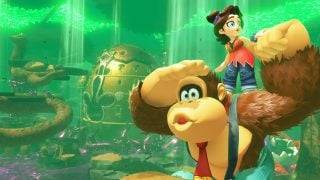The hair-whipping, purple-haired half-genie hero is back for her fifth platforming adventure: Shantae and the Seven Sirens. Since playing Shantae and the Pirate’s Curse on my Nintendo 3DS five years ago, Shantae has become one of my all-time favorite franchises. With each new installment, developer WayForward mixes fun platforming, great music and visuals, interesting power-ups, and laugh-out-loud humor to create something wholly unique. Shantae and the Seven Sirens, the sequel to 2016’s Shantae: Half-Genie Hero, brings back the franchise’s exploration and Metroidvania elements that were lost in Shantae’s last outing — and the game’s all the better for it.
Note: This review is for the Nintendo Switch version of Shantae and the Seven Sirens and may not be applicable to the game’s iOS, PC, PlayStation 4, and Xbox One versions.
Story and premise
Shantae and the Seven Sirens begins with Shantae, her uncle Mimic, and her friends Sky and Bolo arriving on Paradise Island, a tropical resort where Shantae has been invited to perform a live dance with a handful of other half-genies like her. Things don’t go quite as planned, however, as during the performance, all dancers but her are kidnapped. Naturally, it’s up to Shantae to save them all and discover the secrets behind Paradise Island. Players embark on an adventure exploring Paradise Island’s various towns and the mysterious underwater Sunken City below, a series of interconnected dungeons where players will spend most of their time. In each dungeon, players will do battle with both Risky Boots, Shantae’s pirate nemesis, and one of the titular Seven Sirens — enigmatic foes that have plagued Paradise Island since its birth.
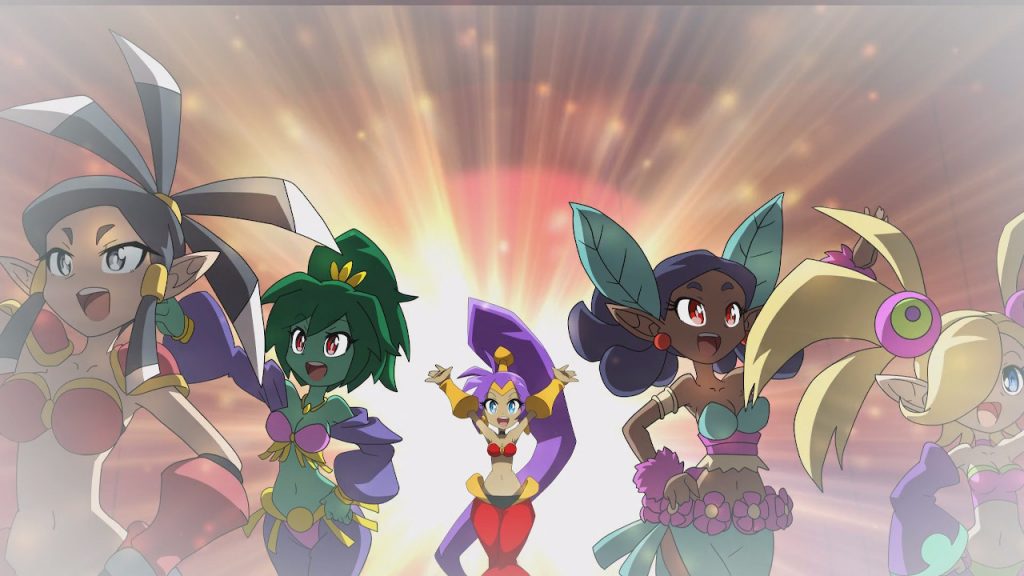
Shantae and the Seven Sirens features fully-animated and voiced cutscenes.
Story-wise, the game isn’t anything special — but Shantae has never been lauded for its story. Its premise is simple and it does the job well. For hardcore fans, there are a few character moments for Shantae that can be appreciated, and some tiny details about her origins are shared. It’s definitely cool getting to see other half-genies in action (that aren’t villains like Holly was in Half-Genie Hero), and each has a unique power that they’re kind enough to share with Shantae. Plenty of beloved characters also return, like Rottytops and the Squid Baron, and are joined by a bevy of great new ones, as well.
I am disappointed, though, in the abandonment of a semi-ongoing story for Shantae. The first three games built on each other, with each continuing off the last game’s plot (with this being most apparent in Pirate’s Curse). Half-Genie Hero “rebooted” the story in a sense, and Seven Sirens continues this, with each game now being a standalone adventure that barely references past titles at all. Sadly, the larger narrative of Shantae seems to have ended with Pirate’s Curse.
Gameplay
Gameplay in Shantae and the Seven Sirens is as fun as its ever been: platforming is tight and Shantae is a joy to control. Players will encounter a huge variety of enemies and boss characters during the game, which can be summarily dealt with using Shantae’s signature weapon: her whippable hair. Shantae also has a huge arsenal of complementary weapons, like rockets, pike balls, scimitars, and fire — all of which can be upgraded into more powerful versions over the course of her journey. Defeating enemies results in collecting gems, which can be spent on items to replenish health and magic and improve Shantae’s weaponry. As a half-genie, Shantae also has the unique power of transformation, allowing her to turn into creatures to navigate areas and perform special dances to unveil hidden items.
Paradise Island is comprised of a few towns and the enemy-filled routes that connect them. The Sunken City, which can be reached via various hatches across the island, is a labyrinth of themed areas that lead into five of the game’s dungeons. Players can also use Warp Rooms to conveniently travel across the island and Sunken City — which is a must considering the amount of backtracking you’ll need to do.
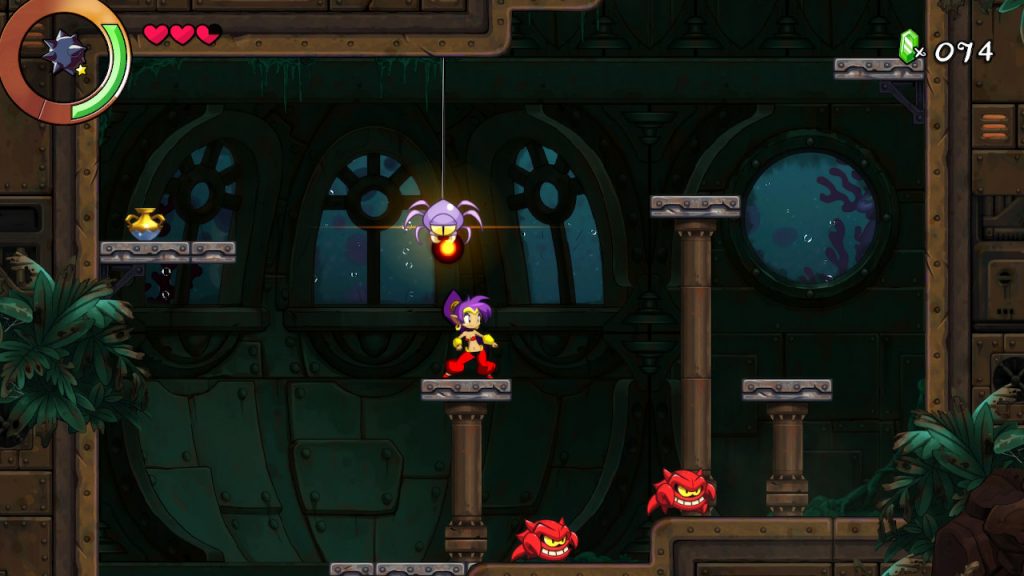
The game features six expansive dungeons, three towns, and loads of other areas to explore.
You’ll spend a lot of time returning to previous areas in Shantae and the Seven Sirens, as new paths throughout Paradise Island and the Sunken City open up with each new ability Shantae learns — from climbing walls as a newt to skating through salt water as a frog. With each dungeon the player completes, they’ll receive a new transformation and special dance. Throughout the map, players will also encounter Heart Squids — sometimes hard-to-reach collectibles that can be turned into additional health via an NPC called the Squidsmith.
Everything considered, Shantae and the Seven Sirens feels more like a sequel to Shantae and the Pirate’s Curse than it does to Shantae: Half-Genie Hero — and it feels like coming home. It’s the Shantae formula perfected. It’s the game I wish Half-Genie Hero had been, but I’m thankful it’s here nonetheless — despite being a few years late. For those who aren’t familiar with Half-Genie Hero, the game did away with Metroidvania-style dungeons in favor of larger outdoor areas. Platforming was still a thing, but exploration was greatly de-emphasized. While Seven Sirens plays much like Pirate’s Curse (albeit with Shantae’s transformations), it also introduces a handful of great new features while also mixing in some additions from Half-Genie Hero.
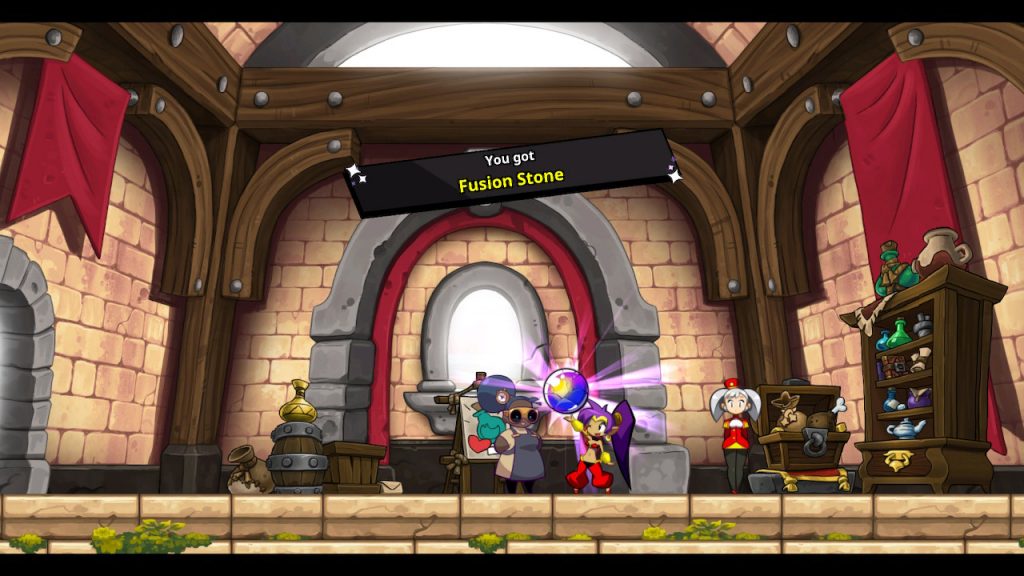
Players will collect “Fusion Stones” after each dungeon, which are used to learn new dances.
Shantae and the Seven Sirens introduces a “Fusion Coin” mechanic, which makes transformations much more convenient. Each time Shantae receives a Fusion Coin, she unlocks a new transformation ability that is bound to a controller button. Players can now swap between transformation powers on the fly instead of having to perform a dance and pick an ability each time, like hitting “ZR” to zip to surfaces as a newt or hitting “ZL” to drop through rocks as a tortoise. I found this incredibly more intuitive than the old method, and it made traversing the game’s many areas so much more fun; I can only hope WayForward keeps this mechanic for future games, as well. Dances still exist, but aren’t tied to transformations anymore. Instead, they’re used to help the player out in the field, like revealing hidden items, enemies, and platforms, lighting up a dark room, or reviving dead plants in return for magic or gold nuggets. These are obtained through “Fusion Stones,” which are used to combine Shantae’s dancing powers with one of her five new half-genie friends’ powers.
Also new is a system that allows the player to enhance Shantae’s abilities with special cards dropped by defeated enemies. The “Bat” card, for instance, will cause Shantae’s boomerang weapon to consume less magic when used, while the “Crab” card will let her crawl much faster. Shantae can equip three cards at a time, and they can be easily switched out at any time via the menu. While sometimes having just one card will allow Shantae to equip it, some require multiple of the same cards to be collected before they can be used. For example, the player will need to collect five “Lobster Jogger” cards before they can equip it. Once equipped, it allows Shantae to automatically draw loot in from a distance when passing. The player can also collect ultra-rare cards based on the seven sirens by trading Nuggets to NPCs — items that are hidden throughout Paradise Island and the Sunken City.
Speaking of cards, did I mention there are a ton of enemies in this game? I mean it. The enemy variety is incredible, with plenty of returning enemies and awesome new ones, to boot. Just look at this snapshot of the card screen, with each card representing an enemy in the game. I didn’t even collect all the cards yet!
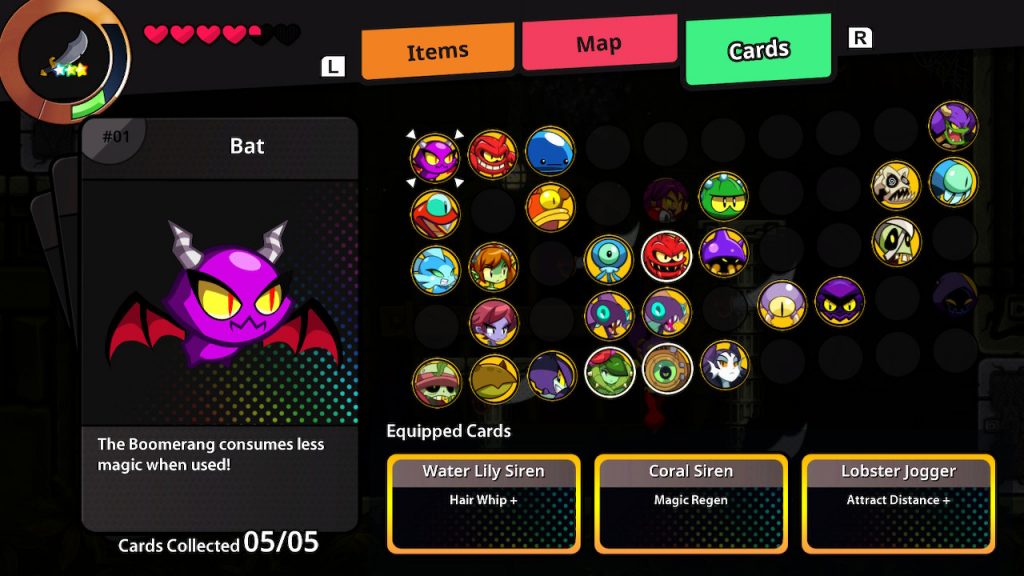
Many monsters were harmed in the making of this card collection.
Enemy variety is probably the biggest improvement long-time fans will recognize in Shantae and the Seven Sirens, especially since it was sorely lacking in Half-Genie Hero.
There’s also a “dancing” mini-game to be found in one of the towns, where players will have to time shots perfectly to hit moving objects above Shantae. In return, they’ll win gems and — if no misses are made — even a Heart Squid. It isn’t the greatest mini-game ever, but it’s still a fun break from trekking across Paradise Island.
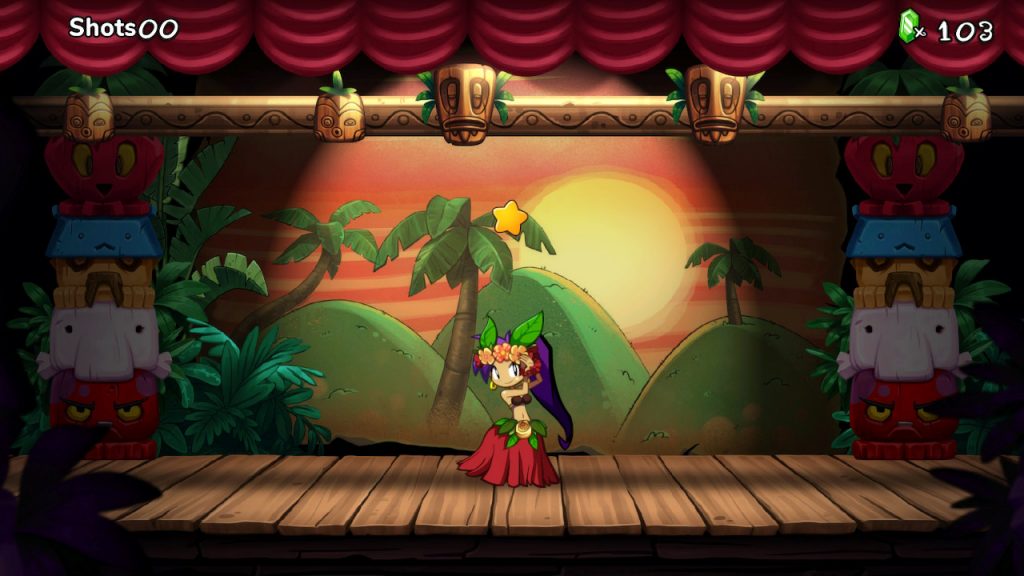
There are a few Shantae series Easter eggs to be found in the background of the Dance Parlor.
But, with all the game’s good comes a handful of bad. There were a few times I simply had no idea what to do next, and the game didn’t do much to point me in the right direction. While some NPCs tied to game progression are indicated with red exclamation points over their heads (a quality-of-life feature that debuted in Half-Genie Hero), more often than not, I didn’t find them very helpful.
At one point, I received a key item — “nuts and bolts” — that I assumed would work to repair any of the many broken fans I’d spotted across Paradise Island. In actuality, this item only worked on one particular fan without any clear indication why it had to be that one and not any other. To be fair, you can find a nearby NPC that will tell you it’s that fan that needs to be repaired, but the solution to this “puzzle” seemed a little obtuse.
In a later dungeon, I entered an empty room with an impassable door at its far end. From my play experience, I knew this door couldn’t be opened yet, so I decided to just leave without going farther in. I wandered the dungeon for about 20 minutes, but ended up lost again. Only when I reentered that room and walked to the center did a new character appear and dialogue was triggered, but I feel like this was a poor design choice on WayForward’s part. Why couldn’t that scene trigger immediately upon entering the room? My reaction upon seeing a dead-end is to just leave, and I think it’s fair to say the same is true of other players, too.
Another area in which Shantae and the Seven Sirens is lacking is difficulty: Those looking for a challenging platformer would be wise to look elsewhere. Apart from the area leading up to the final boss (which have always been infamously challenging in Shantae games), everything else is a cake walk. Personally, I don’t have the patience for hard games (especially hard platformers), so this issue didn’t detract from my enjoyment whatsoever. Without even trying, my wallet was always flush with gems, my weapons were always able to be upgraded, and I always had plenty of food to refill my health and magic meters. As long as you collect every Heart Squid you come across and turn them into Heart Holders, you should have no issues beating Shantae and the Seven Sirens. I didn’t die once. The game is also pretty short — I beat the story in just about nine hours, and that includes backtracking several times to pick up Heart Squids and Nuggets I knew I’d missed earlier. Shantae games are never long, but they are highly replayable. Given how solid Seven Sirens’ gameplay is, I can certainly see myself returning to the game again and again and again.
Presentation
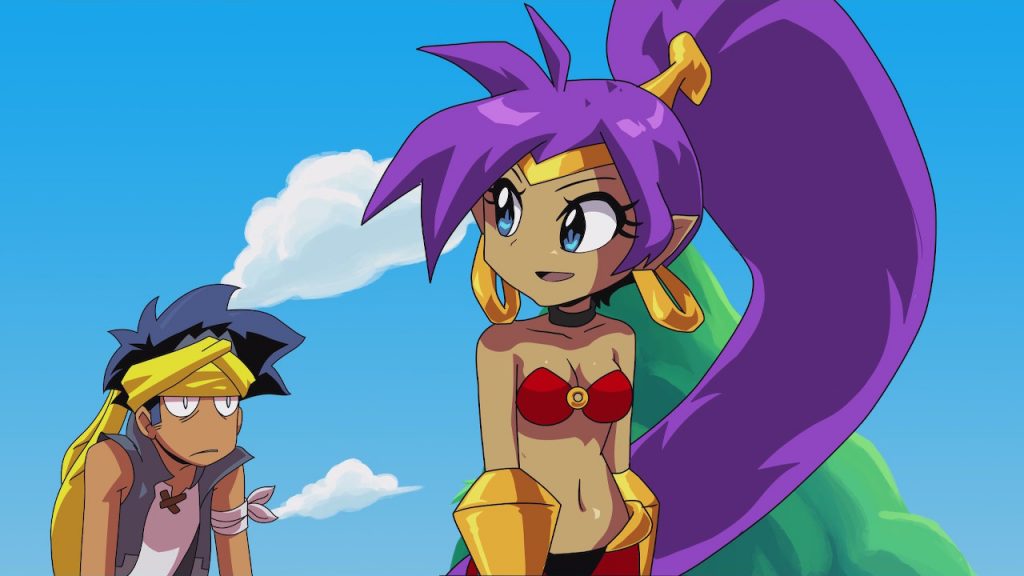
Shantae and her dim-witted friend Bolo arriving on Paradise Island.
Shantae and the Seven Sirens uses the same art style introduced in Shantae: Half-Genie Hero, albeit with a flatter 2D look to accommodate the return of classic dungeons. While I’ve never been the biggest fan of this direction (I much preferred the pixel art seen in Shantae: Risky’s Revenge and Shantae and the Pirate’s Curse), the game still looks great in both handheld and docked mode, with wonderfully animated sprite work, full character art for major players during dialogue, and beautiful foregrounds and backgrounds in all dungeons and towns. A series first, the game also includes fully-animated cutscenes! These are usually just 10-second-long clips showing Shantae entering a boss’s lair, but they’re a welcome inclusion nonetheless. Seven Sirens also features a opening animation by Studio TRIGGER complete with a lyrical theme that is wonderfully anime in all the right ways (although it has some volume issues and is unnecessarily loud compared to the rest of the game; seriously, why you gotta blow out my speakers, WayForward?). Characters like Sky, Bolo, Rottytops, Mimic, and others are also given some short voiced lines for dialogue sequences.
The game’s writing is as sharp and hilarious as ever, too; on several occasions, I found myself repeating dialogue over and over because it was just that good. I do have to point out there are some typos and plenty of grammatical errors to be found, which is a bit of a bugaboo for me… but I’d imagine most players won’t find this an issue at all.
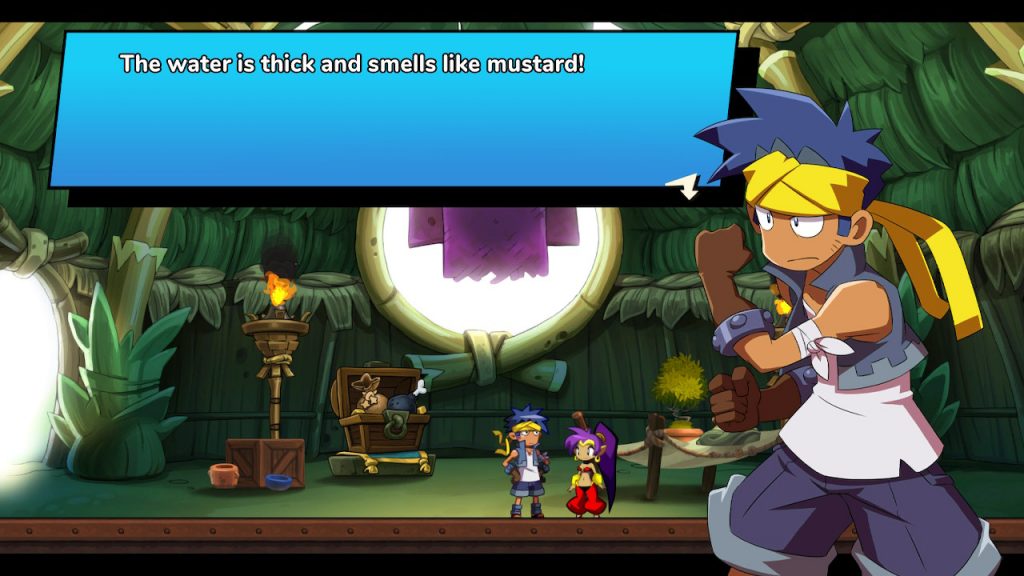
Dim as he may be, Bolo always has the best lines.
A major strength for the game is its UI — especially its inventory and map screens. Shantae and the Seven Sirens’ menus are crisp, clean, and entirely user-friendly — a breath of fresh, ocean air considering the terrible maps and UI of past Shantae titles. The game’s main menu is separated into three sections, the first being an items screen where players can eat restoration items like Pulled Pork Sandwiches and Canned Tuna, see key items like Heart Squids and unlocked abilities, and turn weapon upgrades on and off. The second screen is a map screen, where players can see the entire island, including the Sunken City, at a glance, with indicators for Save and Warp Rooms. The third screen is for card management; here, players can select which cards they want to activate and how many of each they need to collect. Each page of the menu is delightfully designed with dark colors and appealing fonts. Visually, it’s very nice — and I’m a sucker for good user interfaces.
In a huge departure for the series, Shantae composer Jake Kaufman was unable to return for Seven Sirens. Instead, the game’s soundtrack was put together by a team of composers and… I’ve gotta say, Jake Kaufman’s work is sorely missed. His fantastic music is part of the reason why I got into the series in the first place, and while Shantae and the Seven Sirens’ soundtrack is still good, it isn’t Shantae! There are no electronic, Arabian-inspired bops to enjoy here — and I’d argue Seven Sirens’ soundtrack could belong to any other game. But despite the lack of Kaufman’s genius, I would still say Seven Sirens’ music team did a superb job. Each chiptune piece wonderfully reflects its respective setting, from the thumping energy of Armor Town to the mystery of Deep Sea Domain. There’s even unique shop music for each town, which I thought was pretty neat.
…But there’s no version of “Burning Town” (or a traditional “burning town” opening) to be had in Shantae and the Seven Sirens, and I can’t forgive that.
I’m going to hold out hope for Jake Kaufman coming back for Shantae 6. Perhaps a new music direction is justifiable given Seven Sirens’ new setting, but a return to Sequin Land requires the return of Kaufman’s talent.
The verdict
Plain and simple, Shantae and the Seven Sirens is a fun time. It’s charming, it has well-designed dungeons and mechanics, and it respects your time as a player. Not once did I feel the game dragged on for too long, and as someone who has a lot of games I like to play, I’m very pleased with Seven Sirens’ pacing. Shantae has always been a series that knows what it is and does it well, and this game is no exception. The franchise hit a bump with Half-Genie Hero, but I can wholeheartedly say that Seven Sirens is a substantial return to form. If you’ve never played a Shantae game before, Seven Sirens is a great entry point to the series, and if you’re already a fan, I can confidently say you’ll be pleased with what Shantae’s latest outing has to offer.
Shantae and the Seven Sirens launches for Nintendo Switch this Thursday, May 28th. You can pick it up via the Nintendo eShop or snag yourself a physical copy thanks to Limited Run Games. Act fast on that one, though, as pre-orders end on June 14th. There’s also a collector’s edition available for hardcore half-genie heroes.
Leave a Comment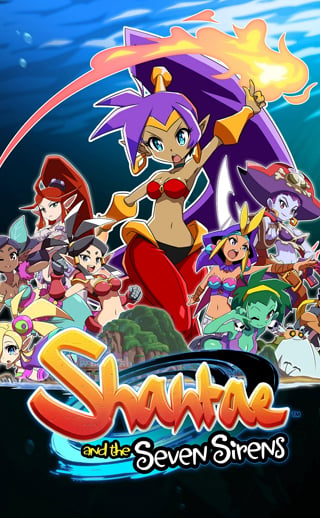
System: Nintendo Switch
Release Date: May 28, 2020
Categories: Action-Adventure, Metroidvania, Platform
Publisher: WayForward
Developer: WayForward

